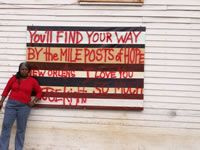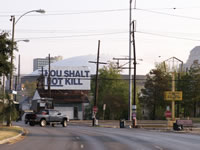"As Sheep Without a Shepherd": A Retrospective |
Anthea Butler |
Images by Dianne Glave |
Three years after writing "As Sheep without a Shepherd" for the online journal The Revealer you might wonder if I am still just as angry about the response to Hurricane Katrina as I was back in early September of 2005. Have no fear, I still am. My anger has turned into disgust and bitterness tempered with occasional glimmers of hopefulness. Since the fateful landfall of Katrina and the breaching of the levee, the lives of thousands of people in New Orleans are changed. Some have not returned to the Crescent City. Others have, only to become discouraged with crime, poor living conditions, and the sadness that seeps around residents as they try to preserve a semblance of their lives in a town that will never be the same.
 |
|
Structural issues are worse now than when the waters were rising. After all this time, insurers have not paid out many of the insured, and lawsuits abound. The lack of affordable housing in New Orleans has led to riots. Magnolia Terrace and other projects have been condemned, even though they are not appreciably damaged. There are over 12,000 homeless persons in New Orleans, most living underneath freeway overpasses. The city council is currently considering a law to make it a crime to sleep outside. I am not surprised that the level of crime, depression, suicide, and despair has risen in the city of laissez les bon temps rouler. Children and teenagers have limited resources in public schools, and are victims or perpetrators of peer violence. And I am certainly not surprised that the Federal Government and FEMA have been profoundly inept in their assistance to those displaced, or that the trailers they provided to some are now leaking toxic formaldehyde. None of these things surprise me, even though they are very disheartening.
What has surprised me, and has been uplifting, is the response of people who return to tough it out in New Orleans. Much has improved since my first trip back to New Orleans in November of 2005. It was a gut-wrenching experience. The smell of death and decay permeated my nostrils as we walked on abandoned, chaotic streets in the Ninth Ward. (Although prior to Katrina many in the Ninth would have been considered impoverished by traditional standards, the service jobs and cheap housing made for a slice of the American dream within the shadow of privilege and wealth.) The French Quarter, largely untouched, seemed frail, with few revelers, and bartenders looking as though they could drink their own stock. Breathing was difficult, and the piles of trash and the detritus of lives piled in front of demolished homes made for a surreal scene.
I've been back to New Orleans several times since writing the Revealer article, and I've found pockets of hope as people slowly try to move back into homes. More businesses are open, and there are patches of life as people sit out on their porches and visit, even if the talk is often poignant and sad. Tourists have returned to the French Quarter, the streetcars are open, and the ubiquitous blue tarps have decreased. Yet outside of the Garden District and the Quarter, New Orleans is still largely a sad wasteland of unmet need and missed opportunities. Those who were able and willing to return have tried to rebuild. An estimated 197,000 impoverished African Americans, however—a large share of New Orleans's original population—have been unable to return. The replacement workforce consists largely of Latino workers, who currently face many of the same prejudices and issues that the African American community faced: low wages, expensive housing, and poor working conditions.
 |
|
These are losses and damages we can track, however imperfectly. The loss that is harder to measure, but promises to be staggering, is the history and living memory of the Creole and African American population of New Orleans. I appreciate the losses of all of the citizens of New Orleans. For those of African descent, however, abandoned to a diaspora of disconnection and despair, an entire history has been washed away. The oral histories of families that have been in New Orleans for three generations or more are gone. According to Social Security estimates, half of the elderly population did not return to New Orleans. The history that they lived, and related to their relatives, is gone. New Orleans, which was 68% Black prior to Katrina, is only 57% Black now. Local churches have closed, congregations have tried to re-establish themselves, with varied success, and the historical memories of the older congregants who died in the floodwaters will never be recaptured. Xavier, the nation's only historically Black Catholic University, has struggled with its campus and library collection. Historic Black Catholic Churches like St. Augustine fought and won reprieves from closure after Katrina, but as of April 2008, 25 Catholic parishes are still on the closure list of the Archdiocese of New Orleans.
It remains to be seen how history will deal with the decimation of much of the lower middle class and the poor of New Orleans. The city's restructuring seems to be headed in the direction of a theme park and playground for well-heeled tourists, with the storied history of both slave and free mingling in the historic streets of New Orleans preserved here and there for local color, if at all. The sharp contrast of the Catholic ethos mingled with the African Traditional religions of spiritualism and vodun, the Jewish population mixing it up with the Protestants, and all partaking of the freewheeling atmosphere and joy of the Mardi Gras season: none of this is the same when those who lent not only their sweat but their soul to the festivities go missing. Before Katrina New Orleans was the model city for those of us who study religion, with its healthy mix of ritual practices permeating the streets in defiance of the traditional oppositions of the sacred and profane. History danced second-line with the present. In the sanitized New Orleans of today, the past is instead a sad and happy memory that waves to us weakly as it disappears, day by day.
So yes, I am sad, and I long for New Orleans to return to its former vibrancy. As a historian, however, I am a pragmatist at the end of the day, and I know that New Orleans can never be what it was. A picture that sticks in my mind encapsulates the remark that perhaps got me into the most trouble in my Revealer piece. I equated President Bush with the Antichrist for not sending aid faster. Harsh, but I meant it at the time. I will not repeat that remark here. Rather, I will simply recall President Bush's speech in Jackson Square, where he pledged the government's help to the people of New Orleans. The past three years have passed an unkind verdict on the President's promises. What stays with me now is the image of President Bush on the Square, in a city without electricity, the St. Louis Cathedral lit up with generators like a Disneyworld castle in the background. Not far from that spot is the port of New Orleans, where the slave ships rolled in. In the news footage of Bush's shameful performance, the strangely lit cathedral, beautiful in its own right, looked to me like a whitewashed tomb. And the darkness was deep behind it. To the slaves that came in on the boats, the church perhaps looked the same way. Then as now the promise of light seemed to beckon beauty, but the reality was a kind of death.

